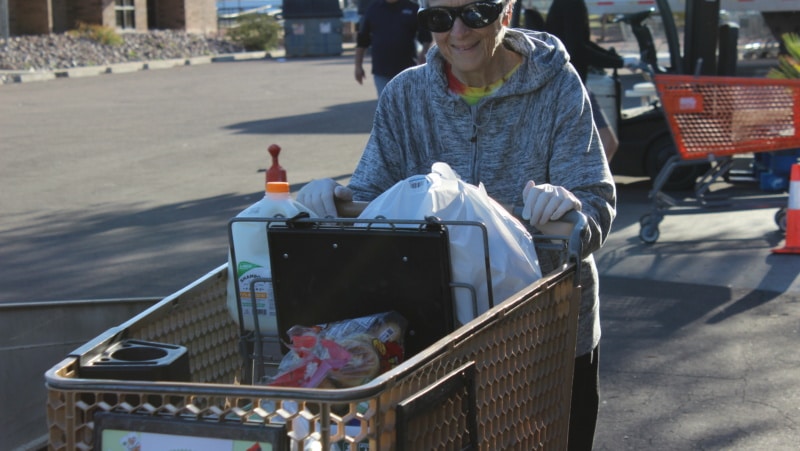The U.S. Census Bureau released new American Community Survey (ACS) data last week showing 18.6% of individuals and 26.5% of children under the age of 18 in Arizona lived in poverty in 2013. Both figures are slight declines from the 2012 poverty rates of 18.7% and 27.0%, respectively, but for Arizonans living in poverty, their plight remained essentially unchanged from 2012. However, counties and rural areas with already high individual and child poverty rates saw their plight worsen.
“For some the economy is improving but Arizona families struggling with hunger and poverty have yet to see it,” says Angie Rodgers, president and CEO of the Association of Arizona Food Banks. “Food banks and safety net programs help these families episodically, but it will take the collective will and action of all Arizonans to increase employment opportunities that pay a living wage to lift these families out of poverty.”
Arizona’s poverty rate ranked 8th in the nation for highest percentage of individuals living in poverty in 2013, while it ranked 11th in highest percentage of children living in poverty. Nationwide, 15.8% of individuals and 21.9% of children under the age of 18 lived in poverty in 2013. In addition, the 2013 Arizona poverty rate remains 30.1% higher than its pre-recession 2007 poverty level of 14.3%. Federal Poverty Level (FPL) guidelines in 2013 were set at an annual gross income of $23,550 for a family of four.
New for 2013, the Census ACS released data for all of Arizona’s Congressional Districts, including the recently created District 9:
| ALL INDIVIDUALS | CHILDREN UNDER 18 | |
|---|---|---|
| District 1 – Ann Kirkpatrick | 22.3% | 31.8% |
| District 2 – Ron Barber | 17.1% | 30.4% |
| District 3 – Raul Grijalva | 23.4% | 30.4% |
| District 4 – Paul Gosar | 17.4% | 25.5% |
| District 5 – Matt Salmon | 9.1% | 9.9% |
| District 6 – David Schweikert | 11.2% | 15.1% |
| District 7 – Ed Pastor | 37.0% | 50.0% |
| District 8 – Trent Franks | 11.1% | 15.5% |
| District 9 – Kyrsten Sinema | 19.4% | 28.7% |
Arizona’s children continue to live in poverty at a higher percentage than the overall population, and suffered greatly in high-poverty counties in 2013. For children under of the age of 18, Apache (51.4% in 2013 vs. 40.9% in 2012), Navajo (45.8% in 2013 vs. 38.4% in 2012) and Mohave Counties (31.0% in 2013 vs. 33.7% in 2012) had the highest child poverty rates. By comparison, 25.5% of children in Maricopa County lived in poverty in 2013 (unchanged from 2012), while in Pima County saw a decrease from 29.2% in 2012 to 26.7% of children living in poverty in 2013. Research conclusively shows children living in poverty are more likely to suffer from food insecurity and health related diseases such as obesity, while also struggling in school academically and behaviorally. Increased resources are needed to combat the near-epidemic child poverty levels in these areas.
For the overall population, many counties treaded water in 2013, although the two most impoverished saw increases: Both Apache (40.1% in 2013 vs. 33.2% in 2012) and Navajo (32.7% in 2013 vs. 30.7% in 2012) Counties saw poverty increases. Coconino County (24.1%) finished with the third highest poverty rate in 2013. Yavapai (16.1%), Pinal (16.3%) and Maricopa Counties (17.7%) had the lowest levels of poverty in 2013. In Pima County, 19.5% of individuals lived in poverty in 2013, while in Yuma County, 17.8% of individuals lived in poverty in 2013. By metropolitan area, Glendale (26.3%), Tucson (25.3%) and Flagstaff (24.4%) had the highest levels of poverty in 2013. Gilbert (5.9%), Scottsdale (9.3%) and Chandler (10.4%) had the lowest levels. Phoenix had a 23.6% poverty rate in 2013.
These 2013 Census ACS poverty figures align with recently released Feeding America Map the Meal Gap food insecurity data to paint the same picture: In Arizona, one in five individuals and more than one in four of our children struggle with hunger and poverty. These figures have not changed significantly since the recession began in 2008. More details on Arizona poverty can be found here. Note that three- and five-year Census ACS poverty estimates are considered more statistically reliable than one-year ones. The Census ACS will release the three-year data sets comprising 2011-13 on October 23 and the five-year data sets comprising 2009-13 on December 4.

